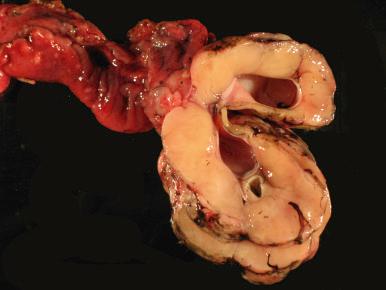Physical Address
304 North Cardinal St.
Dorchester Center, MA 02124
The distinction between primary and secondary tumors of the ovary is one of the more difficult morphologic dilemmas in gynecologic pathology, because there are similarities in both clinical and histologic features in many cases. The reported frequency of metastatic tumors in the ovary varies with the study design (e.g., autopsy vs. surgical material) and the country of origin ( Table 28.1 ); however, it ranges between 15% and 25% of all malignancies involving the ovary. Among cases that clinically or pathologically mimic a primary ovarian tumor, most originate from the endometrium, the gastrointestinal tract, the pancreas, and the breast. Metastases to the ovary connote a poor prognosis, with overall 5-year survival of approximately 20%.
| Demopoulos et al. | De Waal et al. | Lobo et al. | Yada-Hashimoto et al. | Lee et al. | Khunamornphong et al. | |
|---|---|---|---|---|---|---|
| Study site | United States | Netherlands | Portugal | Japan | Korea | Thailand |
| Metastatic tumors a N (% of total ovarian tumors) |
76 (13%) | 116 (15%) | 120 (26%) | 64 (21%) | 112 (14%) | 170 (30%) |
| Primary Sites | ||||||
| Müllerian N (% of metastatic tumors) |
17 (22%) | 30 (26%) | 12 (10%) | 26 (41%) | 11 (10%) | 53 (31%) |
| Endometrium | 14 | 23 | 9 | 15 | 10 | 18 |
| Fallopian tube | 1 | 1 | 0 | 2 | 0 | 6 |
| Cervix | 2 | 6 | 3 | 9 | 1 | 28 |
| Choriocarcinoma | 0 | 0 | 0 | 0 | 0 | 1 |
| Non-müllerian | ||||||
| Gastrointestinal tract N (% of metastatic tumors) |
23 (30%) | 36 (31%) | 88 (73%) | 24 (38%) | 86 (77%) | 80 (47%) |
| Colon | 12 | 23 | 38 | 7 | 46 | 36 |
| Stomach | 6 | 7 | 22 | 15 | 34 | 16 |
| Small intestine | 2 | 3 | 4 | 0 | 0 | 0 |
| Appendix | 1 | 2 | 17 | 1 | 2 | 6 |
| Pancreaticobiliary tract | 2 | 1 | 3 | 1 | 4 | 21 |
| Liver or not specified | 0 | 0 | 4 | 0 | 0 | 1 |
| Breast N (% of metastatic tumors) |
32 (42%) | 32 (28%) | 15 (13%) | 9 (14%) | 2 (2%) | 11 (6%) |
| Lung | 1 | 0 | 1 | 1 | 2 | 2 |
| Renal/urothelial | 2 | 1 | 2 | 2 | 0 | 0 |
| Lymphomas/leukemias | 0 | 0 | 0 | 1 | 2 | 4 |
| Others | 0 | 8 | 2 | 0 | 0 | 1 |
| Unknown | 1 | 9 | 0 | 1 | 9 | 19 |
a Excluding cases with metastases from contralateral ovarian tumors.
Gross pathologic analysis can often be helpful in distinguishing a primary ovarian from a metastatic tumor to the ovary. This subject is discussed more fully in Chapter 25 , but here is a brief summary:
Primary mucinous tumors of the ovary are often larger (frequently 10 cm to 30 cm) than metastatic mucinous tumors, which are often 10 cm or less in greatest dimension.
Metastatic neoplasms often affect both ovaries, whereas most primary ovarian neoplasms are unilateral, except for high-grade serous carcinomas, which are often bilateral and unlikely to be confused with metastatic disease.
Multinodular cortical involvement and surface implants can be suggestive of a metastasis.
Homogeneous expansion of the ovarian parenchyma without cyst formation occurs with metastatic breast cancer, signet ring cell tumors, and lymphomas, and it is less common in primary epithelial ovarian carcinomas.
Large tumors with conspicuous necrosis and hemorrhage are common in metastatic colonic carcinomas (which are frequently bilateral).
Endometrial adenocarcinoma account for 15% to 20% of all ovarian metastases. Morphologically, endometrioid and serous carcinomas of the uterus can be indistinguishable from endometrioid and serous carcinoma of the ovary, and therefore the pattern of spread is often the distinguishing feature. An additional complication is that as many as 12% of patients who present with an endometrioid-appearing ovarian adenocarcinoma also have a synchronous endometrial carcinoma. This subject is reviewed in detail in Chapter 25 in the differential diagnosis of endometrioid carcinomas of the ovary. Briefly, a metastatic endometrioid carcinoma of the uterus should be suspected if the endometrial tumor is deeply invasive in the myometrium or invades myometrial vessels. Also, a metastasis is likely if the ovarian tumor involves only the ovarian surface or has a multinodular growth pattern in the absence of ovarian endometriosis. There are no biomarkers to distinguish endometrioid tumors of the uterus and ovary; however, some studies suggest that ER and WT1 can be used to distinguish lower and upper tract serous carcinoma. Recent studies looking at mutations in “synchronous” endometrial and ovarian endometrioid tumors demonstrate shared mutations, inferring clonality and likely metastatic relationship between the tumors rather than true synchronous primaries in the majority of cases.
The frequency of a uterine leiomyosarcoma metastasizing to the ovary is only 3.9%. Metastatic endometrial stromal sarcomas is also infrequent. In a series of 10 metastatic endometrial stromal sarcomas, only one involved the ovary ( Fig. 28.1 ). Nevertheless, if one encounters either a leiomyosarcoma or an endometrial stromal sarcoma in the ovary, a metastasis from the uterus (possibly remote or unrecognized) should always be excluded before making a primary diagnosis.

The conundrum of distinguishing a primary tubal serous carcinoma from a metastasis to the tube is discussed in more detail in Chapter 21, Chapter 24, Chapter 25 . In summary, there is increasing acceptance that the presence of a serous tubal intraepithelial carcinoma (STIC) in the setting of widespread disease often represents the primary tumor, despite its small size in comparison to the metastatic foci. Supporting evidence includes the fact that STICs and metastatic serous carcinoma contain identical p53 mutations. Additionally, a multinodular growth pattern and/or superficial cortical involvement (in contrast to a solitary expansive lesion) in the ovary in the setting of a STIC is in keeping with a fallopian tube primary. There are no immunostains to distinguish fallopian tube and ovarian/peritoneal primary serous carcinoma; however, an algorithm for distinction has been proposed.
Cervical carcinomas metastasize to the ovary in less than 5% of cases, with the majority of these being adenocarcinomas. Regardless, as endocervical and endometrioid carcinomas of the ovary have morphological overlap, the former should be considered when an adenocarcinoma is encountered in the ovary, especially in a younger woman with or without a history of a cervical primary carcinoma. The primary tumor is usually unremarkable ( Fig. 28.2A ), but when cervical carcinoma involves the ovary, it often lacks gross and microscopic features classically seen in metastatic disease. The tumor may be cystic, and the ovarian surface is often smooth (33%), disease is often unilateral (55%), and mass size can be larger than 10 cm (25%) (see Fig. 28.2B ). Nevertheless, there are morphologic features/clues that suggest a cervical primary, including high nuclear grade, luminal cytoplasmic eosinophilia with apically situated mitoses, and minimal stratification (see Fig. 28.2C ). Patterns resembling mucinous and intestinal carcinomas may also be seen (see Fig. 28.2D and E ). In rare cases, extensive adenocarcinoma in situ or minimally invasive cervical adenocarcinomas have been documented to spread to the ovary. Human papillomavirus (HPV) analysis of the ovarian tumor is a valuable adjunct in difficult cases, because metastatic cervical adenocarcinomas are positive for high-risk HPV, and primary ovarian carcinomas are not. The pathologist should be aware of the possibility of tubal involvement; the presence of diffuse and strong p16 is supportive of a cervical primary (see Fig. 28.2F ). It should be noted that serous and endometrioid carcinomas in the ovary can also express diffuse and patchy p16, respectively, so that such results would require additional morphologic and clinical correlation.

Gastrointestinal carcinomas and carcinoid tumors can metastasize to the ovaries and may be difficult to distinguish from primary ovarian tumors, both histologically and immunohistochemically.
The most common pattern of metastatic gastric carcinoma is the signet ring carcinoma (so called Krukenberg tumor ). However, Krukenberg tumors may also originate in the intestine (including the appendix), breast, pancreas, or biliary tract. The majority of cases present with symptoms related to a pelvic mass, because the primary lesion may be occult. Tumors are usually bilateral solid masses that grossly demonstrate a mucoid, glistening cut surface ( Fig. 28.3 ). The signet ring cells are filled with cytoplasmic mucin ( Fig. 28.4A ) and may be present as scattered single cells or in tubular or glandular patterns (tubular Krukenberg tumor) (see Fig. 28.4B ). A subset of cases may contain a prominent spindled cellular stroma. The differential diagnosis for signet ring cell carcinomas in the ovary includes a primary ovarian carcinoma with focal Krukenberg-like areas arising in a background of a more characteristic pattern, such as a mucinous (most common) or endometrioid carcinoma. Pure signet ring cell carcinomas of the ovary exist but are exceedingly rare. When encountering a pure signet ring cell carcinoma in the ovary, a metastasis should always be excluded, and additional sampling should be considered if no classic variant of ovarian carcinoma is identified. In cases with a prominent stroma, the differential diagnosis may also include a luteinized thecoma or a sclerosing stromal tumor. In difficult cases, a mucin stain and/or a keratin immunostain may be useful to accentuate the malignant cells. Cytokeratin 7 (CK7) and CK20 can show overlapping staining patterns in gastric and ovarian tumors and have limited utility in this distinction. The use of MUC antibodies has been proposed to help distinguish gastrointestinal and ovarian mucinous tumors, but none are entirely sensitive or specific.


Become a Clinical Tree membership for Full access and enjoy Unlimited articles
If you are a member. Log in here